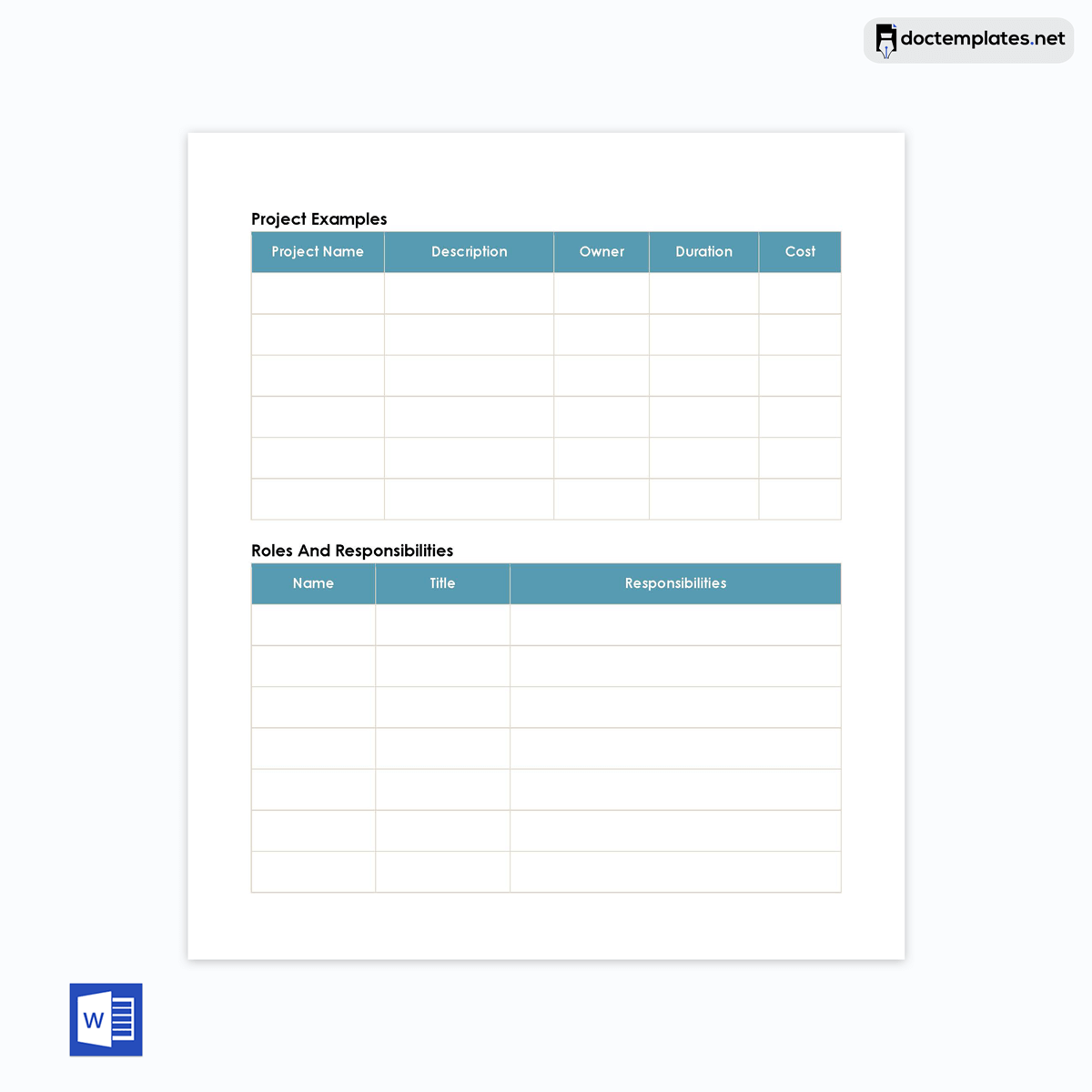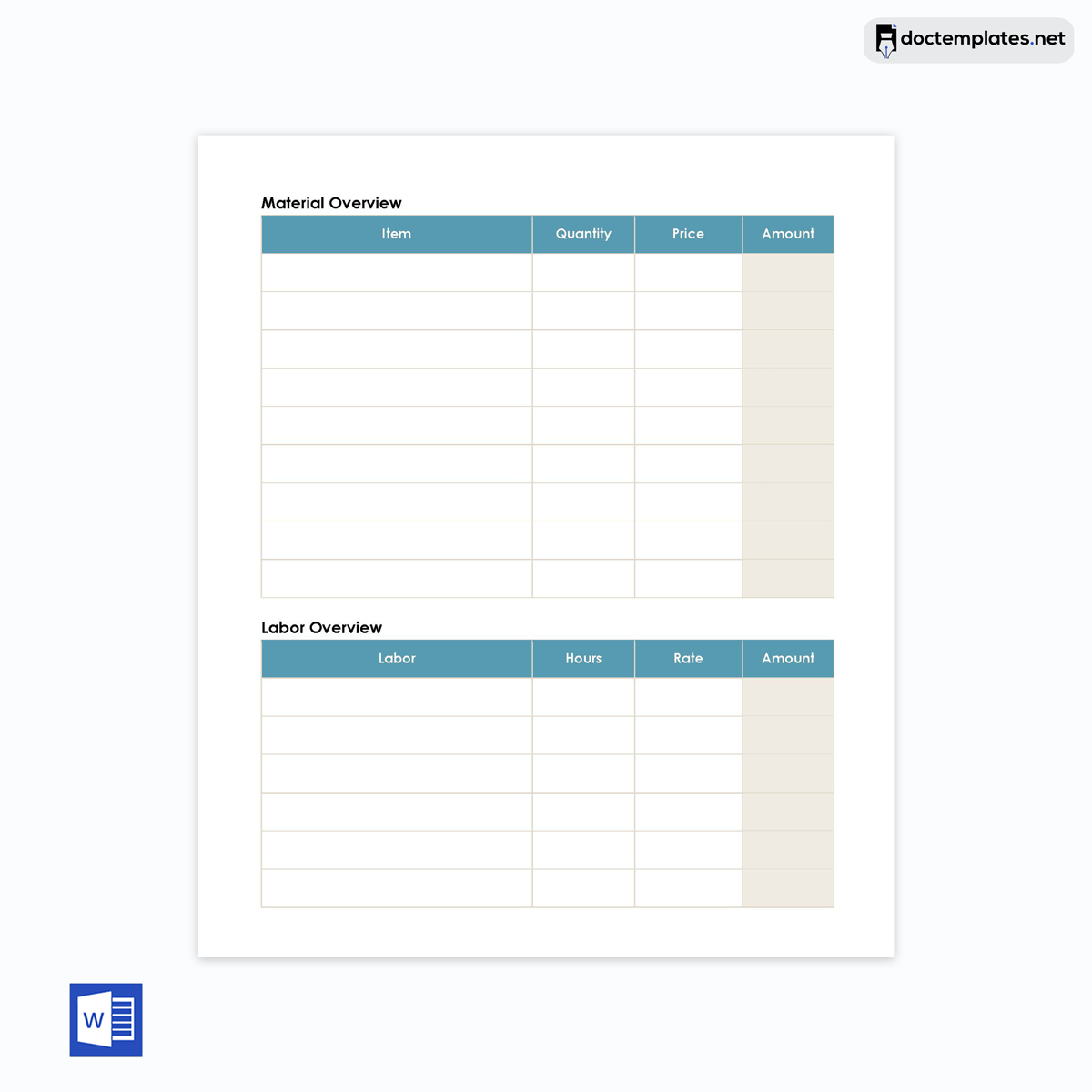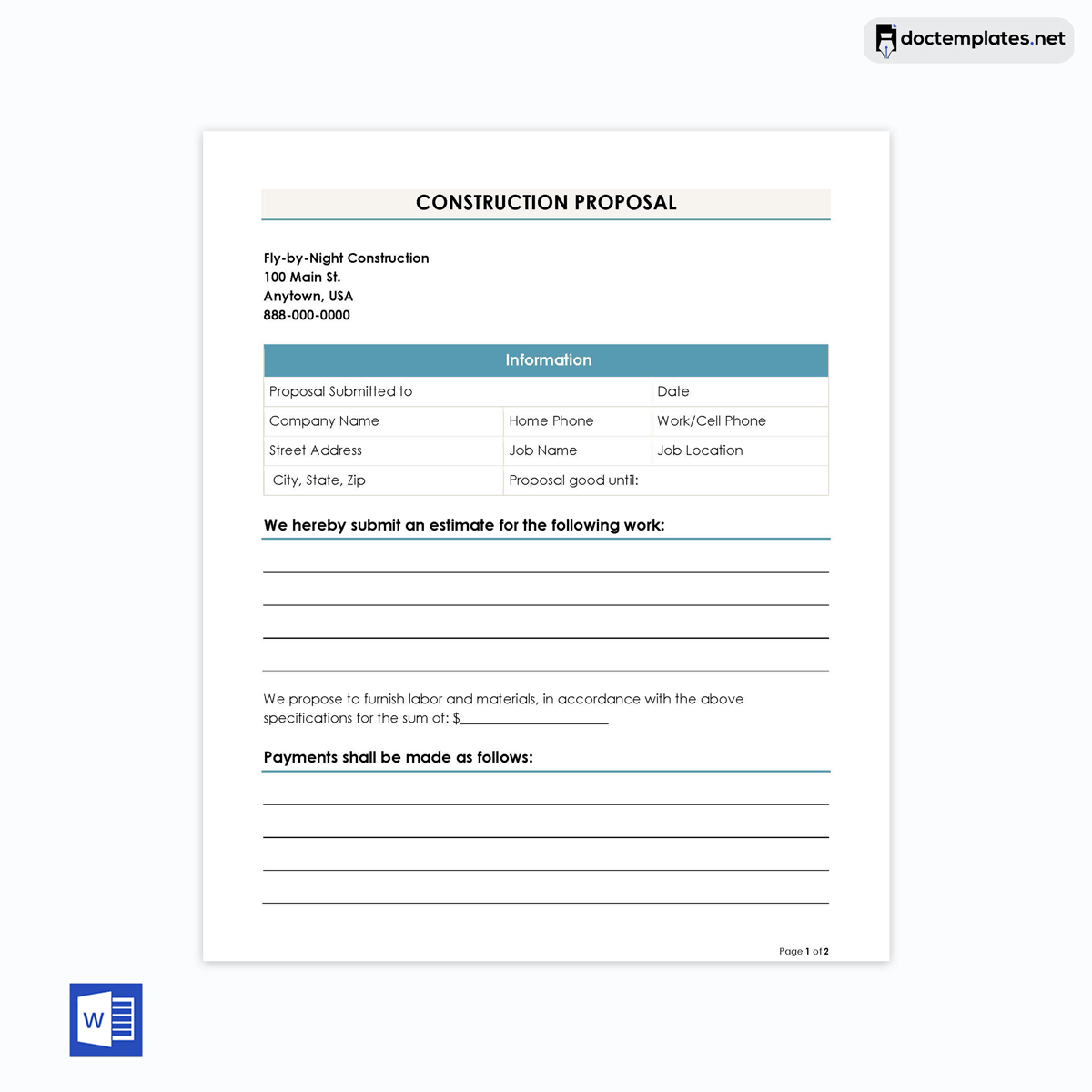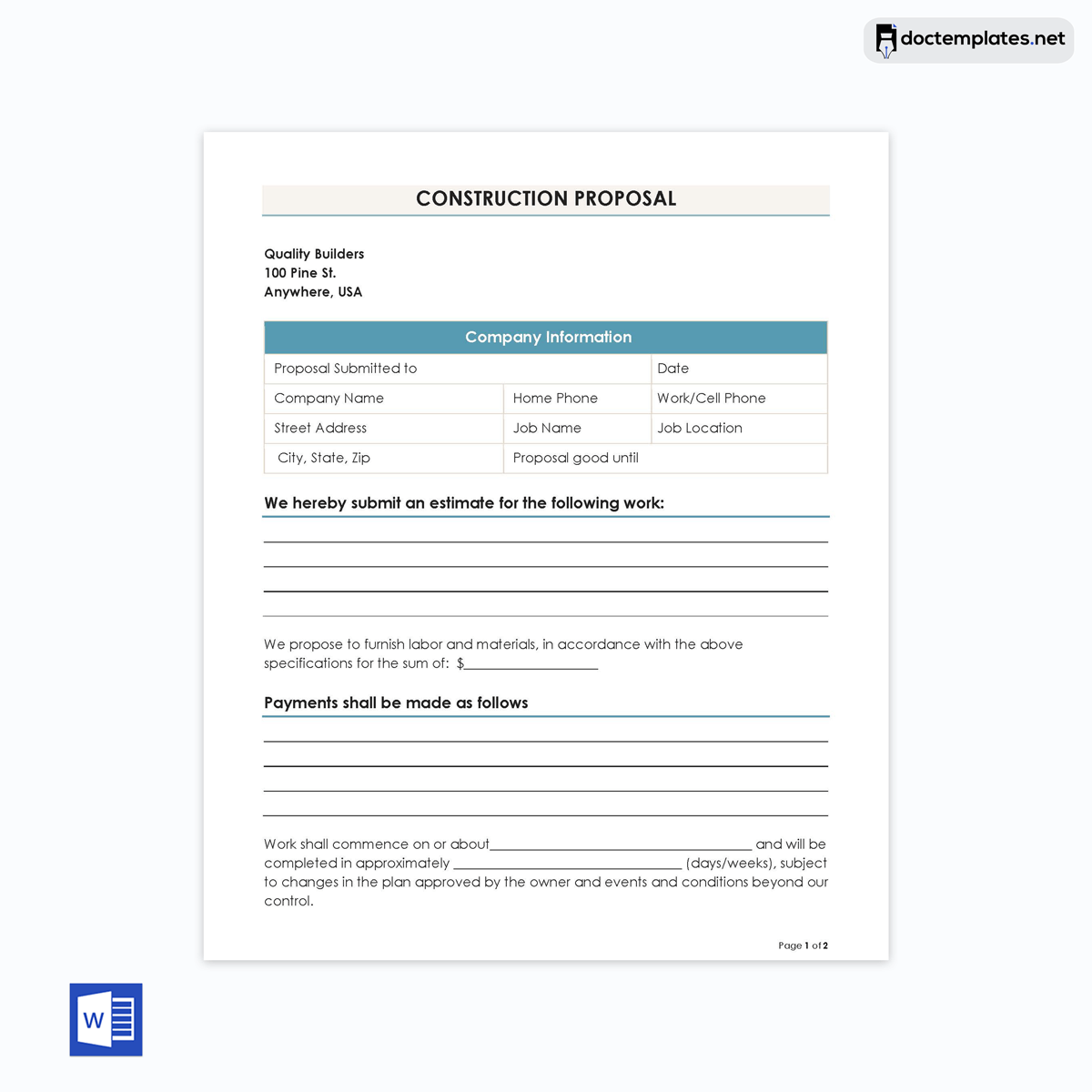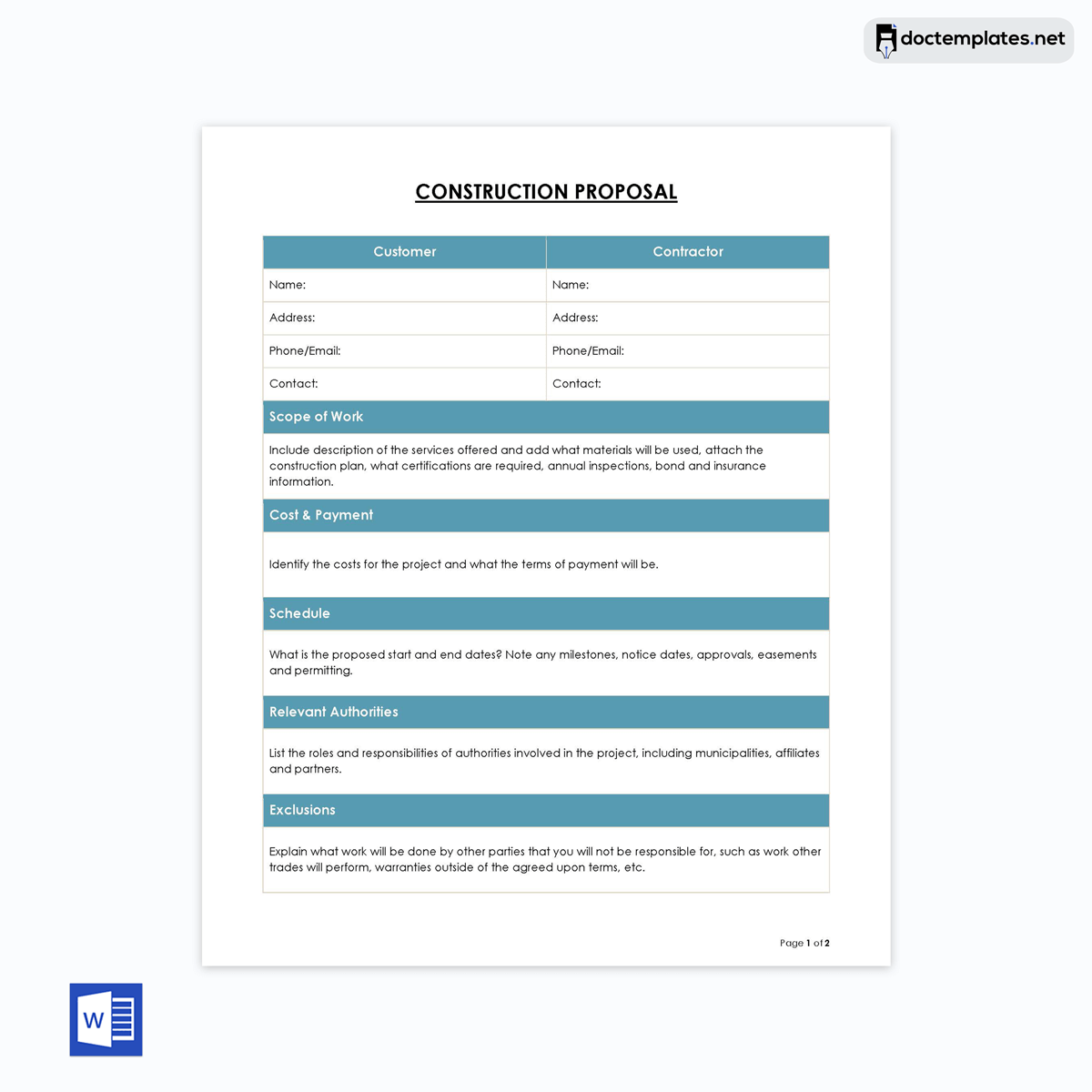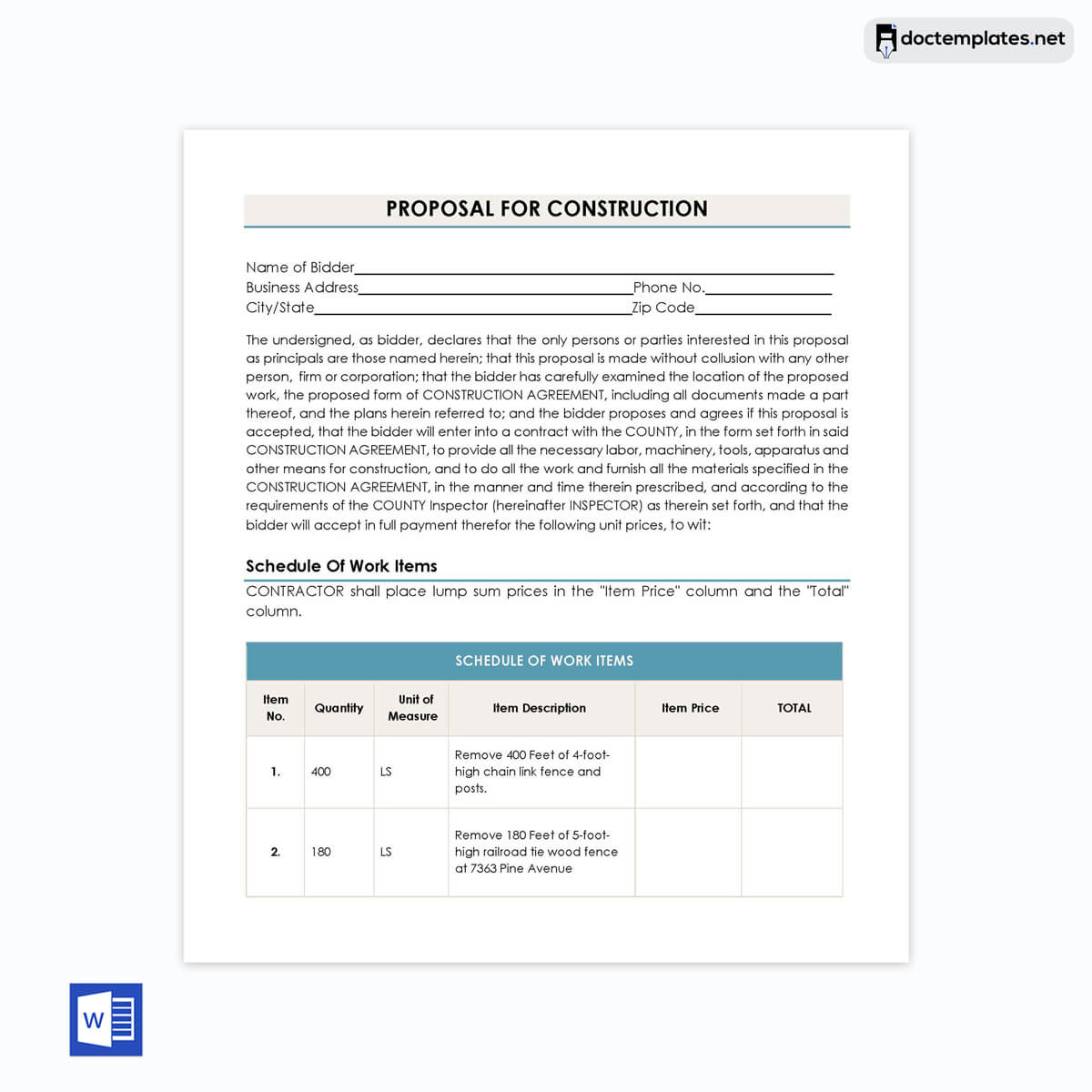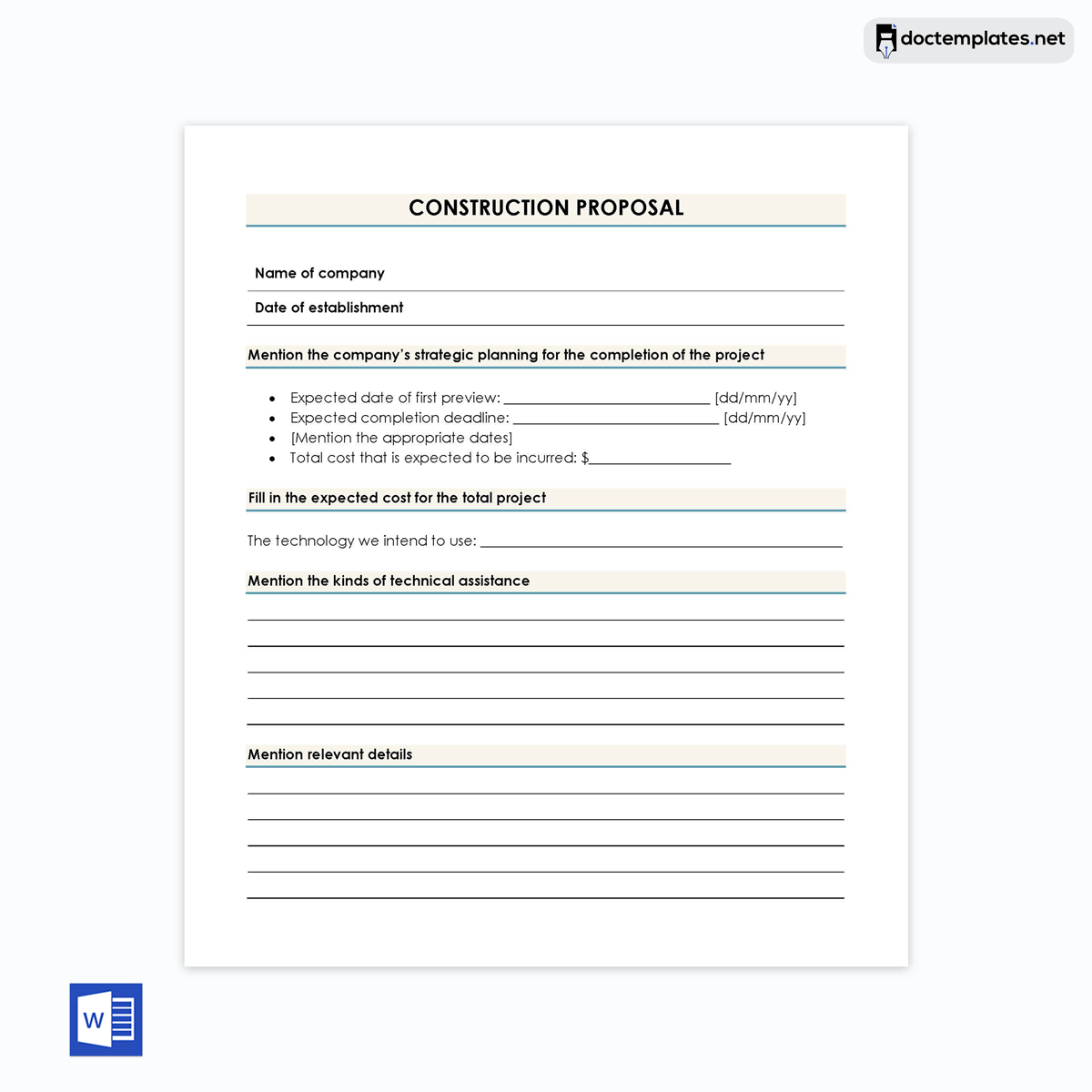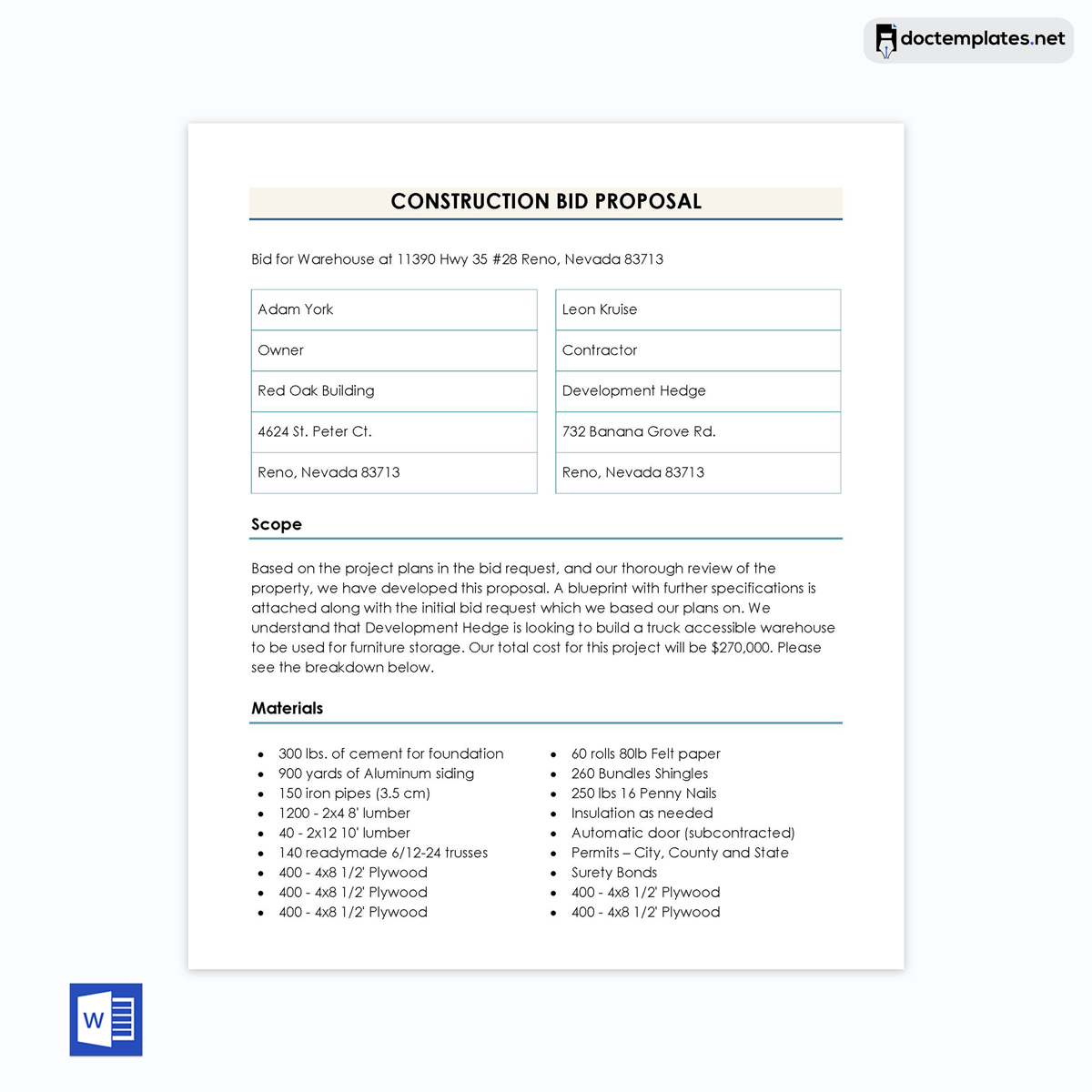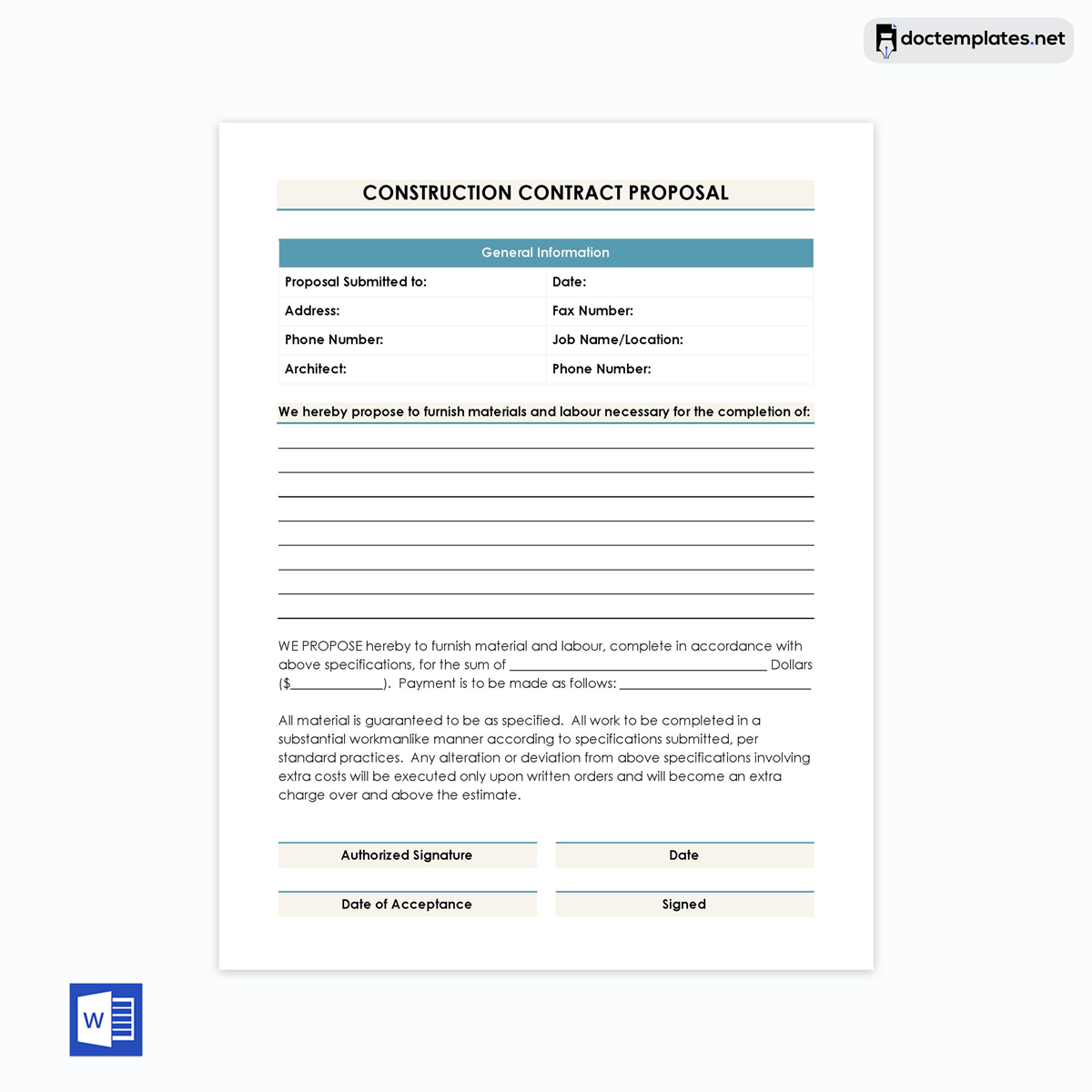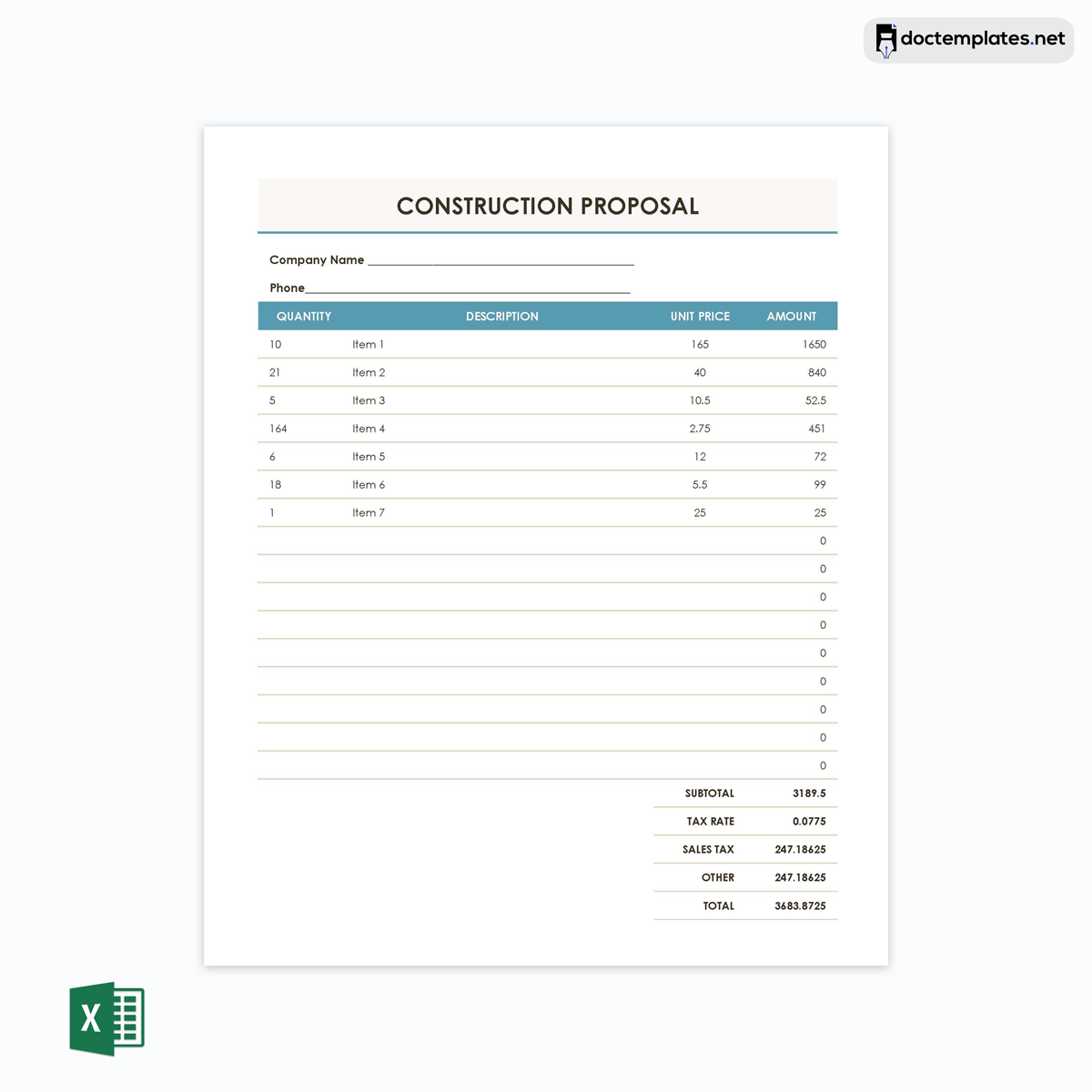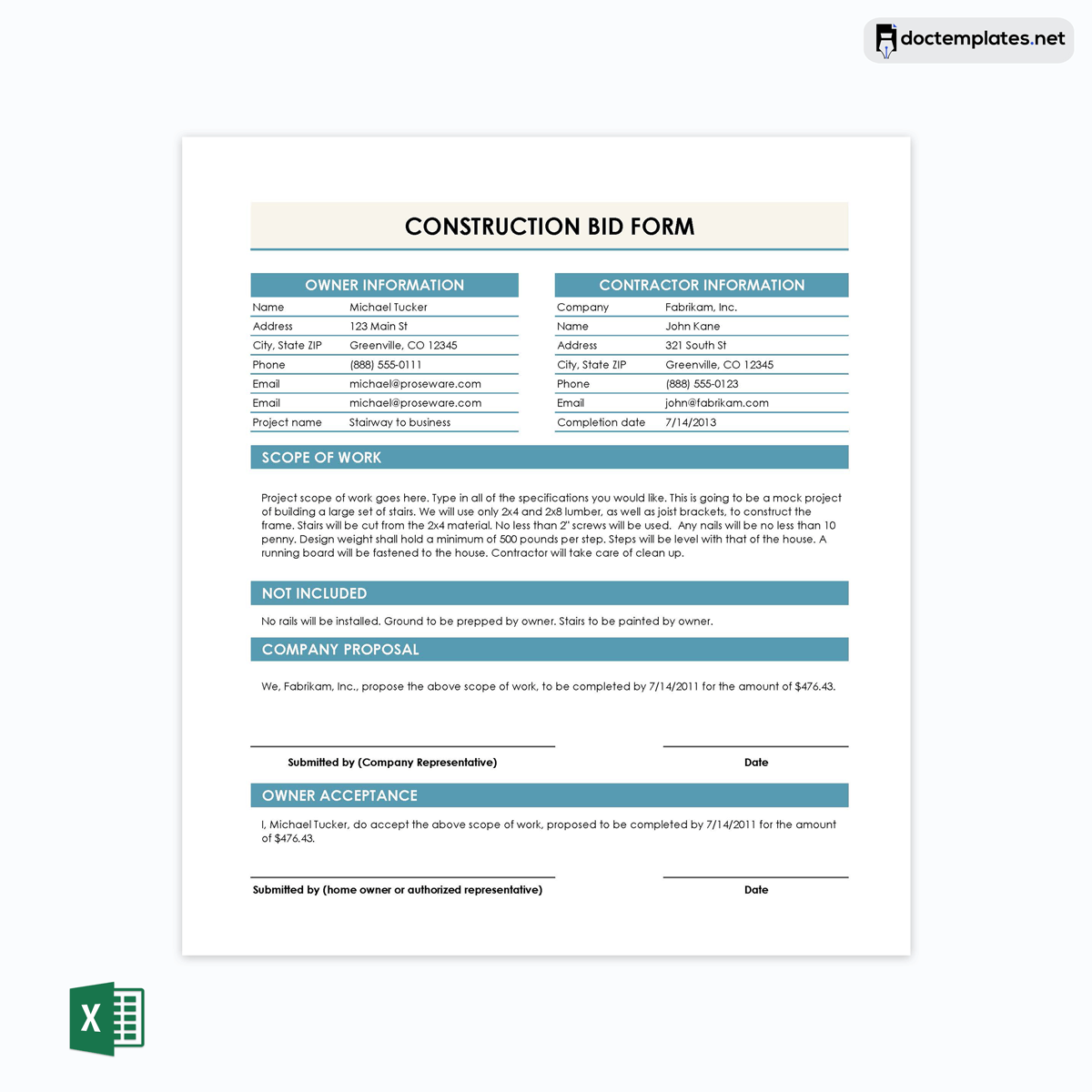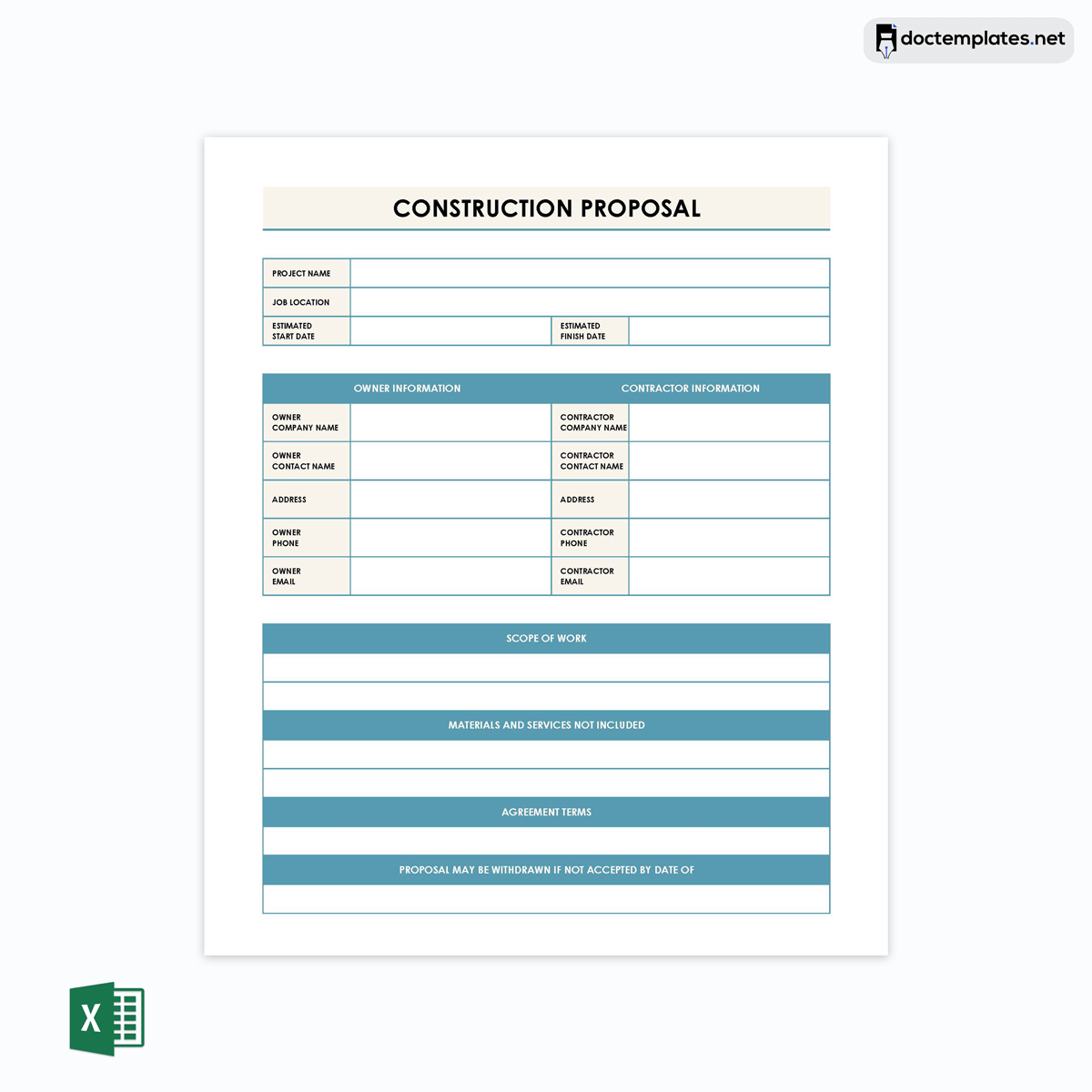A construction proposal is a document submitted by a company to a potential client that acts as a blueprint of how the proposed project will be handled.
Note that an agreement between the parties involved is meant to protect them against exploitation. It contains accurate details of what the company will offer the client if they are considered for the project. Additionally, it outlines the financial expectation of the project. This allows the client to conduct a feasibility test and see if they can fund their project idea.
It is crucial for a construction company to draft a good proposal, as it displays their qualifications, expertise, and reputation to the potential client. Furthermore, it allows you to envision how the project will unfold; this acts as a schedule of the tasks to be handled, the materials required, and the workforce needed to complete the project.
It is a legal agreement between your company and the client. This means you are supposed to handle all the project tasks agreed upon in the contract. Any additional tasks will require a new proposal and agreement. This is an effective way of minimizing conflicts and misunderstandings.
This article will guide you on factors to consider before creating a Construction proposal template, elements to include in the template, and certain best practices to make it effective for the potential client.
Construction Proposal Templates
A construction company can use templates to prepare a proposal to attain success. They are beneficial as they uphold consistency and professionalism throughout it. You can access great documents below that will make it easy for you to prepare a detailed and effective construction proposal promptly and with less effort. They can be customized to fit your demands.
Pre-Steps Involved in Construction Proposal-Making Process
A construction proposal should make it easier for you to explain to the client how you will make their project idea become a reality. Therefore, it should be detailed, informative, and incisive.
Here are steps to consider before writing it:
Research the project comprehensively
Before writing and submitting a proposal, you must clearly understand the proposed project. Therefore, conducting research will allow you to gather important information about the project. As a result, you will develop a detailed document that outlines the advantages of proceeding with the project. This is an effective way of convincing the client that you are the right company for this project.
Check state and local laws
When writing a proposal, adhering to state and local laws is crucial. These laws are guidelines for creating and what to include in it. Note that these laws vary from state to state. In most states, these laws are mandatory if you want your proposal to be legally binding.
Meet the client
The essence of the proposal is to impress the client and make them give you the project. However, convincing the client may not be easy, especially if you submit it. Therefore, meeting and interacting with the client in person and understanding their demands is crucial, as this will give you a competitive advantage over the other candidates.
Choose a proposal template or make your own
You can use a pre-made template available online to make a perfect proposal. With this document, you only need to fill in the missing information for a complete and detailed proposal. However, you can make and use it if you feel like the pre-made ones do not satisfy your requirements. They are usually effective and less time-consuming.
Information to Include in Template for Construction Proposal
You must prepare a detailed document for an effective proposal to convince a project owner to give you their construction project. Therefore, it must capture all the relevant details meant to be included in it.
If you are making a customized template for it, you must include the following fundamental sections:
Contact information
Ensure to include your official name, physical address, phone number, and email address in this section of the template. You can also add the contact details of other relevant personnel at the construction company that the client can speak to. Contact information is needed to facilitate communication between you and the recipient.
Including your company logo for better visual presentation and credibility is also important. In addition, you should include the client’s details, including their name, address, phone number, and other relevant contact information. The proposal can be a bid or an official request to offer your construction services. If accepted, it can act as a binding contract, ensuring that all the contact details are accurate.
Detailed scope of work
Start by listing the company’s services, tasks to be done, deliverables, and the project phases. Ensure that you outline all the construction work that will be involved in the project, including the equipment, materials, and labor. You should also mention the certifications required, the insurance information for the project, and the required inspection.
Always be truthful and detailed to avoid being stuck with work that you do not do. The scope of work provides limitations to the work you are promising to undertake for the client. A detailed scope of work thus prevents you from doing work you did not agree to due to unclear limitations.
Cost estimation and payment schedule
This section of the template is meant for cost estimation for all direct expenses, such as construction materials, labor supplies, allowances, machinery, and equipment, plus indirect expenditures, such as your running costs. Ensure you also include a payment schedule, which is important for your cash flow. The payment schedule should detail how and when you want to receive payments, plus what should be done in case of extra work or unforeseen issues.
That means that you should include the terms and conditions of payment, alongside the cost estimation, that ensures you are protected from late payments or refusal to pay by the client. Adding the cost estimation also helps the client with the bid selection process. It also aids the client with planning for the resources needed and budgeting for the project.
Client’s obligations
The next section of the template should outline what is expected from the client. This includes any information or resources the client must provide to facilitate a smooth construction project. This demonstrates you are familiar with what is required to undertake the project successfully. Clarifying the client’s obligations is also a way to safeguard yourself from unprecedented legal liabilities.
Construction schedule
Next, the template must provide your prospective client with a program of how the construction project will be implemented from the project’s beginning and end dates. This is important since any changes to the schedule mean changes to the costs. For the schedule, you should also include the milestone dates and estimated delays, such as the time needed to get permits and approvals or delays from bad weather and poor delivery services.
You should also mention the order of work and the order of completion. It is about giving the client an idea of when their project will be completed according to your construction plan. This signifies you have a viable action plan that can be relied on to meet the project objectives.
Relevant crew details
The next section of the template requires details of the team or authority that will also be associated with the construction project. This will include the roles and responsibilities of business partners, affiliates, and local municipalities. It is important to clarify the individuals or entities you intend to cooperate and collaborate with, as this increases your credibility and chances of securing the job.
Changes and extras
It is important for the client to be aware of everything regarding the construction, even the expected changes. In this next section of the template for your proposal, you need to list all the anticipated modifications to the project scope. This section must also indicate the resources, such as the extra workers required to implement the changes. This is because there needs to be an agreement on how payments will be made if the changes occur.
Also, there should be a plan on how many extras will handle any modifications the client decides to make to the project once you have started construction. This information is needed for planning purposes so that appropriate preparations are made to limit the impact of the changes when and if they occur.
Hidden defects and unforeseeable conditions
Apart from the expected changes, your proposal should also define who will be held accountable for unforeseeable conditions and hidden defects. This includes mold in the walls, unexpected boulders in the ground, or anything else that might require extra work. Such conditions often result in extra costs. So it is important to define these defects and how unforeseeable conditions will be handled before starting the project to prevent future conflicts, time wastage, and money loss.
Exceptions
Apart from listing what you do under the scope of work, you need a section in the template to specify the construction project tasks you will outsource elsewhere. The exceptions section allows you to include all the work parties will do, such as subcontractors, furniture stores, and other trades. This section gives the client an idea of all parties involved and their responsibilities in the project.
Terms and conditions
At this point, you need to specify the terms and conditions of the agreement between you and the prospective client. You need to list your rights and responsibilities and those of the client. The terms and conditions let each party know their respective contractual obligations and associated repercussions should parties violate the contract. A bid can also be a binding contract, meaning you should include the agreement’s expiration date. It is advisable to have an expiration date that you and the client can adjust instead of leaving it open-ended.
Warranty
A template for creating a construction proposal must have a warranty section where you will list everything you are liable for or in charge of regarding the project. This includes things you will fix and the specific circumstances that warrant the decision. You must also provide details of all situations you are not liable for. Warranty adds assurance to the quality of work you provide. It also adds credibility to your bid, which increases your chances of securing the work.
Signature line
If the client approves the proposal and gives you the construction project, they must sign the document before you can begin working. Signatures are a way to formally attest that the involved parties have read, understood, and agree to the proposal’s provisions. Once the bid is signed, the signatories are expected to honor the terms and conditions until the project is completed.
Best Practices to Consider When Preparing Construction Proposal
A construction proposal should be easy to read, accurate, detailed, and prepared on time. Also, the information within it should be able to reflect your company’s mission and vision. Therefore, there are things you should consider when creating it, such as:
Be specific and detailed
In a proposal, each section is crucial as it provides relevant information about you and how well you can handle the proposed project. Therefore, it is important to be detailed and specific depending on the project at hand. It is necessary to provide the client with accurate and reliable information that they can use to make informed decisions.
Give it a personalized touch
When creating a bid proposal, it is important to make it simple and elegant simultaneously. Therefore, adding your company’s logo, colors, and fonts is an effective way of personalizing it. However, it should be easy to read and understand regardless of the personal touch.
Ensure your data is accurate
A client significantly depends on the information provided in the proposal to select the right company for the project. Also, the details in it are often used to make huge decisions before, during, and after the project has started. Therefore, ensuring that you provide accurate and reliable data throughout the proposal is crucial.
Use estimating software (Optional)
There are instances where the client operates on a first-come, first-serve basis. This is where the client will review and consider the proposal submitted before the given deadline. Therefore, it is crucial to have a way to prepare and submit them promptly. Using estimating software will allow you to create your construction proposal quickly and easily. However, using estimating software is optional.
Key Takeaways
- The construction proposal should contain relevant components and accurate information based on the requirements of the project at hand.
- Its template must include your contact details, the scope of the work to be done, and an estimated cost of the whole project.
- When creating it for your client, you should research the project and adhere to all local and state laws.
- It should be prepared in a way that informs the client about your qualifications, expertise, and skills in the construction field.
- Ensure that your document outlines the obligations of the client and all the terms and conditions to be followed before, during, and after the project.
- It is considered a legal agreement. That means that it offers protection to you and the client.
- For an effective and efficient way of creating professional and accurate construction proposals, it is advisable to use pre-built templates. You can also use estimating software if you want to create them quickly.
